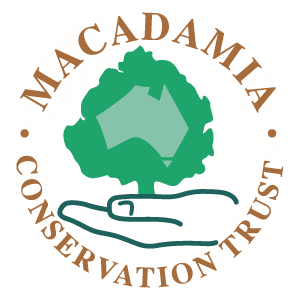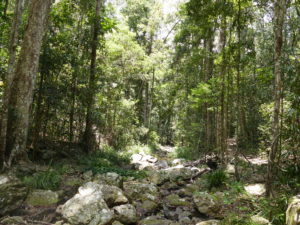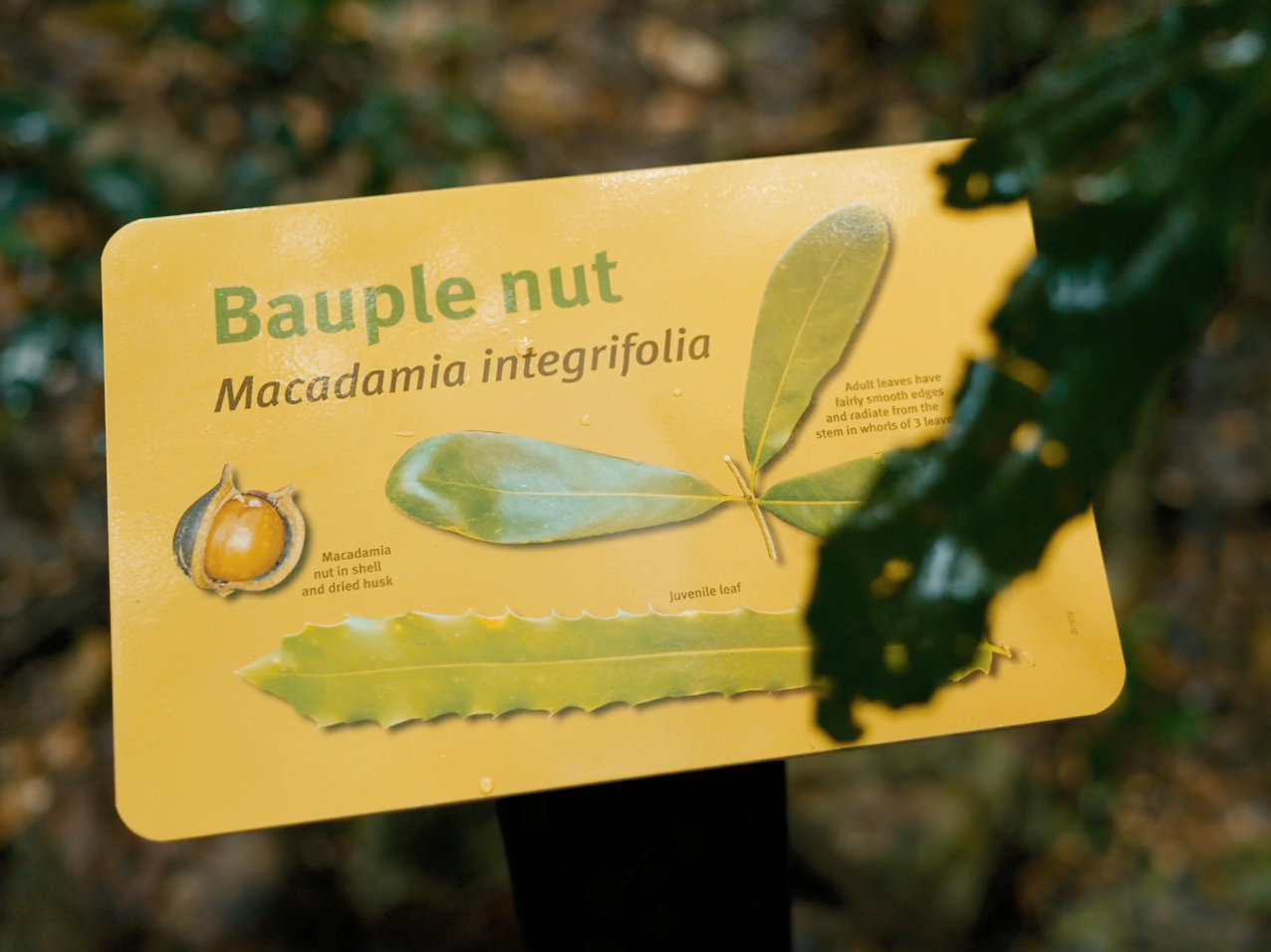In an exciting new initiative from the Macadamia Conservation Trust and Queensland Parks and Wildlife Service, visitors to Amamoor State Forest in the lovely Mary Valley can experience macadamia trees growing in their original habitat via the new Walk with Wild Macadamias track.
Walk with Wild Macadamias
The Walk with Wild Macadamias track on the Fig-tree circuit starts across the road from the picnic ground at the Amama day-use area – look for the sign at the entrance.
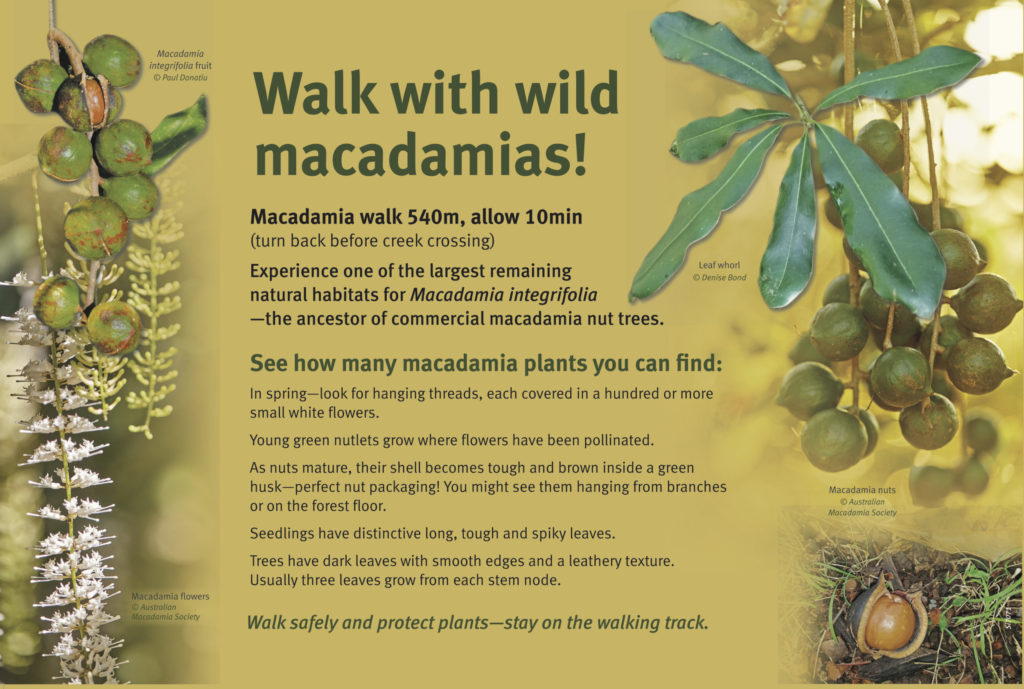
Experiencing Walk with Wild Macadamias only takes 10 minutes, walking through shaded rainforest to the creek and back over a distance of about 540m.
If you have the time and are well prepared, you can extend the walk to visit a giant fig tree and a cascading creek on the Fig tree circuit, or do the whole Amama walk. See the Amamoor State Forest web page for walk details to choose walks that are right for you.
Amamoor State Forest
Visit the Amamoor State Forest web page for all the details you will need for your forest visit and to check Park Alerts for any current closures.
Use these links for the forest walk descriptions, track grade details, safety information and photos from the walks: Macadamia walk, Fig tree circuit and Amama walk.
Phone reception is patchy at Amamoor, so it’s a good idea to download the information before you get there.
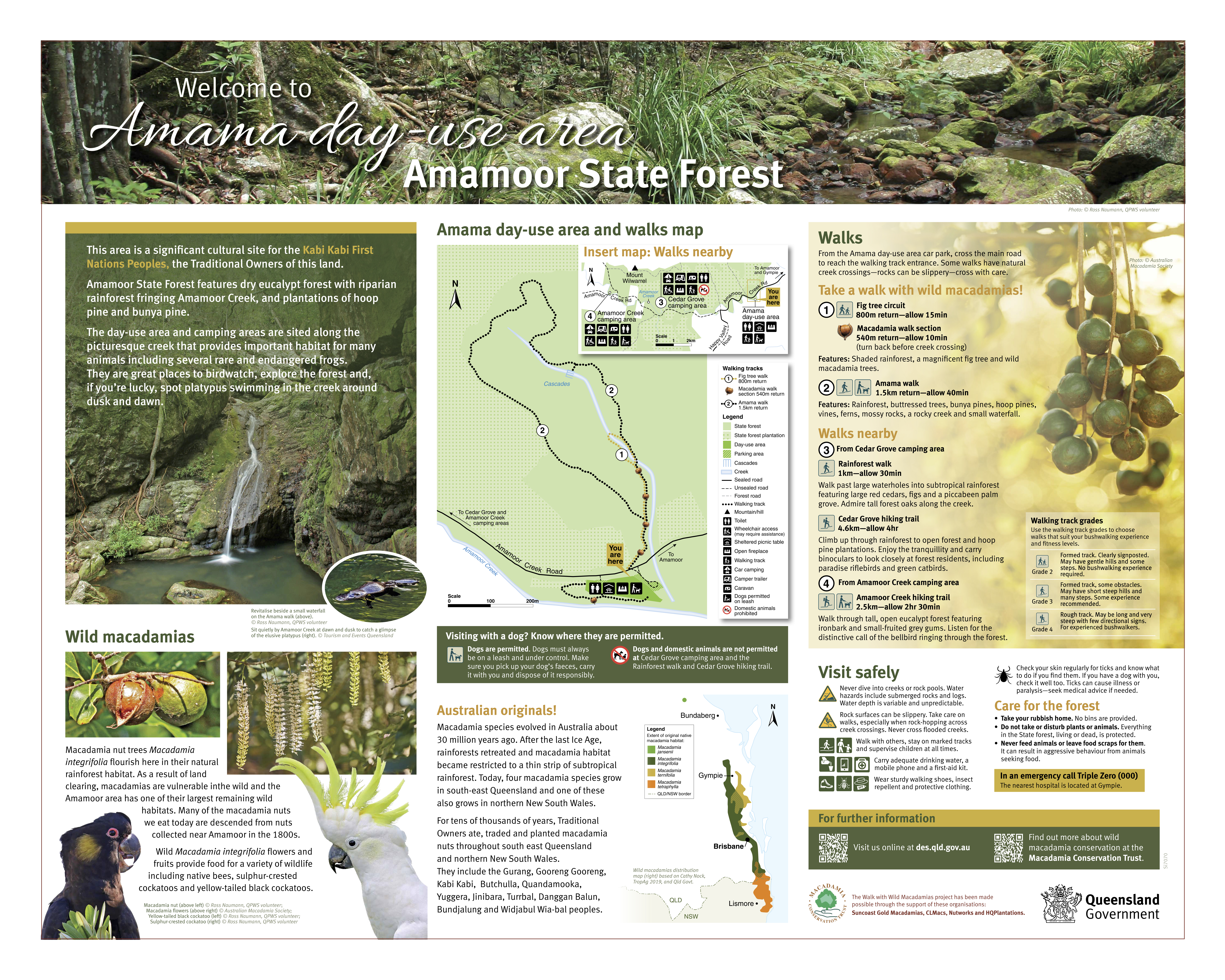
Bauple Nut – Macadamia integrifolia
The macadamia species local to the Mary Valley area is Macadamia integrifolia, commonly known as Bauple or Bopple Nut from its northernmost habitat at Mount Bauple. It grows in a narrow zone of sub-tropical rainforest along the coast from Mount Bauple to the Currumbin Valley. This local species is the origin of the thriving global macadamia nut industry.
Historic Bunya Pines
The walk also features historic Bunya Pines, marked with climbing holes cut by Traditional Owners to collect bunya nuts.
How many Bauple nut trees can you find?
We have placed signs next to a few trees along the Walk with Wild Macadamias. Some people “get their eye in” and can then find other trees, but sometimes the macadamias just seem to blend into the forest – see how many you can find, using the identifying clues below.
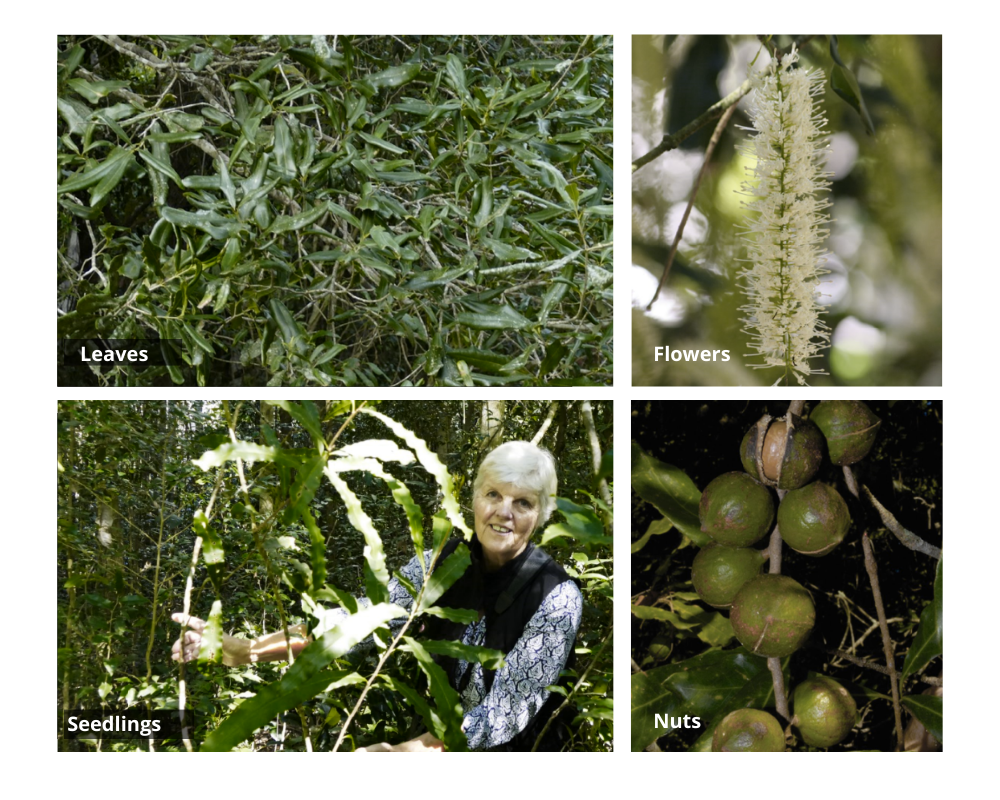
Leaves: Macadamia trees have dark green leaves between 6 to 14 cm long with a short stalk and wavy but smooth edges (no spines, or just a few at the base). Usually three leaves grow at each stem node. Juvenile leaves (on seedlings) are much tougher, with prickly edges, and at least twice as big as mature leaves. New leaves are a delicate pale green.
Bark: The bark is a dark grey/brown, sometimes marked with pale lenticels, like tiny crescent moons.
Flowers: In spring, hundreds of small white flowers grow on long hanging threads. Trees growing in heavy shade may not flower. Look for flowers on trees hanging over the creek or in a patch of sunlight.
The flowers are pollinated by native bees and other insects. Unpollinated flowers drop off the flower stem, while a tiny green bump grows at the base of any pollinated flower. If all goes well, each of these will turn into a macadamia nut. From the hundreds of flowers, there may be only one or two per stem that grow a nut to maturity. Occasionally, a whole bunch will grow, and the slender flower stem thickens up to hold the weight.
Nuts: The nuts grow inside a protective green husk. When ripe, the green husk splits to reveal a shiny brown shell. As the husk dries out, it peels away from the nut. Sometimes this happens when the nut is still on the tree, sometimes after it has fallen to the ground.
Not many animals can break the nut’s defences. Some insects can bore through the shell, laying their eggs inside to feed on the rich nut. Native (and introduced) rats can gnaw a hole and extract most of the nut, and cockatoos can also crack the shell to dig out the nut.
Seedlings: The leaves you see from the ground to eye level might confuse you – they can be quite different from the mature leaves. Some of the juvenile leaves may be longer, and quite prickly.
Why are these trees important?
As a result of land clearing, there are not many macadamias left in the wild and the Amamoor area is one of their largest remaining forest habitats. Wild Macadamia integrifolia flowers and fruits provide food for a variety of wildlife including native bees, sulphur-crested cockatoos and yellow-tailed black cockatoos.
What’s in a name?
The first macadamia to be given a scientific name was Macadamia ternifolia, which has bitter nuts. Folia means leaf and terni means three, signifying three leaves growing at each node. When botanists realised that there was a different species, with edible nuts, they looked for a way to distinguish it from Macadamia ternifolia. The new species also had three leaves per node, but where the leaves of Macadamia ternifolia are spiky, the leaves of the edible species had smoother edges. This led to the name integrifolia – folia for leaf and integri meaning entire.
Australian original
Macadamias diverged from the rest of the Proteaceae in Australia around 60 to 70 million years ago. After the last Ice Age rainforests retreated and macadamia habitat became restricted to a thin strip of sub-tropical rainforest. Today four macadamia species grow in south-east Queensland and one of these also grows in northern New South Wales.
For tens of thousands of years, Indigenous Australians ate and traded macadamias throughout south-east Queensland and northern NSW. Traditional owners of macadamia habitat include: Gurang, Gooreng Gooreng, Kabi Kabi, Butchulla, Quandamooka, Yuggera, Jinibara, Turrbal, Danggan Balun, Bundjalung and Widjabul Wia-bal peoples.
How long do macadamias live?
Macadamias are a long-lived, mid-canopy tree. They don’t reach to the top of the canopy, but they do need a patch of sunlight to grow into a full tree.
They are good at waiting. Ian McConachie from the Macadamia Conservation Trust has been monitoring a healthy macadamia tree in dense forest that has remained at its original height of one metre for over 40 years.
No-one knows how old macadamias can grow. The oldest known tree is the Walter Hill tree planted in 1858 in the Brisbane Botanic Gardens (pictured). This is a magnificent tree, still growing and producing nuts.
Macadamias can grow new shoots from damaged stumps, for example if a trunk gets knocked over by a flood or storm, or burnt, so it is possible that some trees may have survived over hundreds of years.
The Macadamia Conservation Trust is currently researching the life-span of macadamia trees.
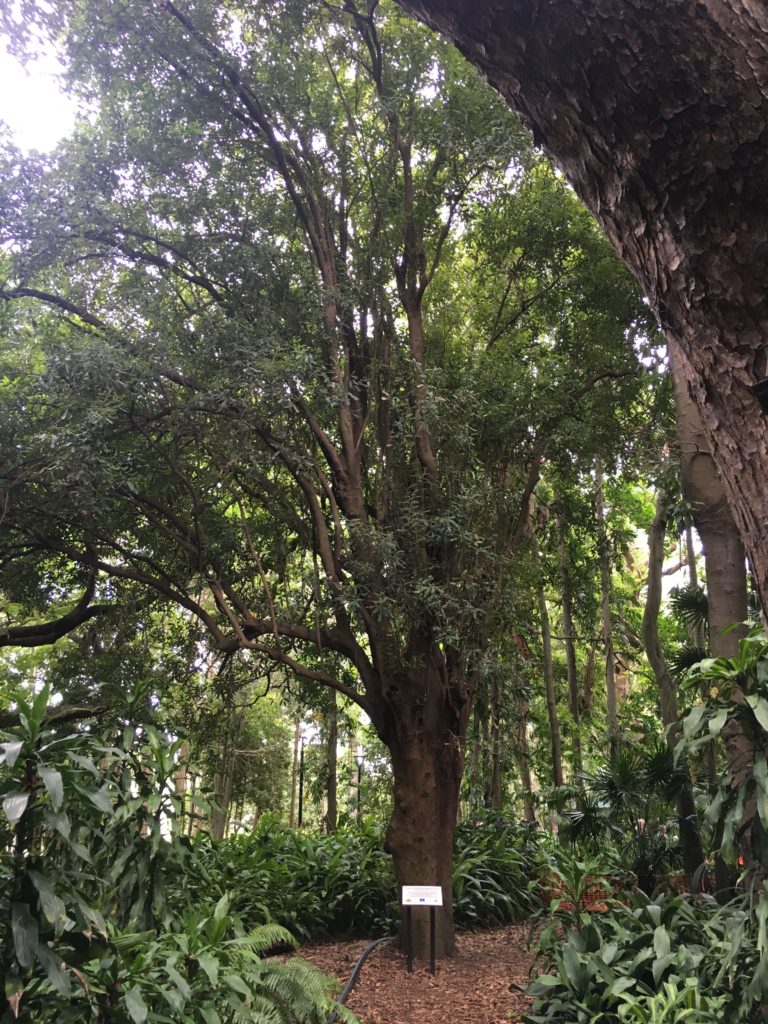
Thanks to our wonderful sponsors …

